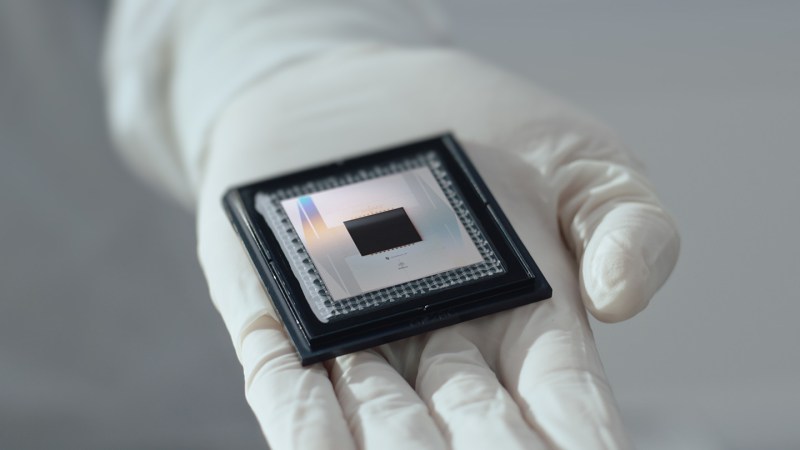Science
Google’s Quantum Breakthrough: Achieving Verifiable Advantage

Researchers have reported a significant advancement in quantum computing, claiming that Google’s Willow quantum chip has achieved verifiable quantum advantage. The announcement, made on October 22, 2023, in the journal Nature, highlights a quantum calculation that traditional classical computers cannot replicate, with results that can be confirmed as correct. This milestone marks a crucial step in demonstrating the practical capabilities of quantum computers.
At a news conference on October 17, physicist Tom O’Brien from Google Quantum AI in Santa Barbara, California, emphasized the importance of verification in quantum computing. “If I can’t prove to you that the data is correct, how can I do anything with it?” he stated. The calculation in question measures a phenomenon referred to as “quantum echoes,” which the Willow chip executed 13,000 times faster than the Frontier supercomputer, one of the most powerful in the world. The full set of calculations would take around 150 years on Frontier, but Willow completed them in just days.
The significance of this achievement lies in the verification process. Previous claims of quantum advantage have often been undermined by advancements in classical computation that nullify those advantages. According to Scott Aaronson, a computer scientist at the University of Texas at Austin, other claims of quantum advantage have faced challenges in verification efficiency. He pointed out that while some quantum calculations have been verified, the time required grows exponentially with the complexity of the task.
Google’s latest calculation is distinctly more efficient to verify, provided another quantum computer of similar capability is available. Aaronson noted that achieving efficiently verifiable quantum advantage has been one of the field’s significant hurdles in recent years. “This is a decent candidate,” he remarked.
The researchers employed 65 qubits from Willow to conduct the quantum echo calculation. They executed a sequence of random operations on the qubits, then reversed those operations, effectively simulating a return to the initial conditions. This method allows the extraction of a verifiable signal from a chaotic system that would typically obscure information. The complexity of this process makes it difficult for classical computers to replicate successfully.
In a paper posted on arXiv.org, the team, which includes Google researchers and collaborators, described how their technique calculates the spatial arrangement of certain portions of two molecules in three-dimensional space. Their findings correlate with results from traditional laboratory methods, such as nuclear magnetic resonance, although they do not yet surpass classical calculations.
Despite this limitation, Aram Harrow, a quantum physicist from MIT who was not involved in the study, praised the connection of quantum computing to real experimental scenarios. He noted, “Connecting their quantum computer to a real experiment is very nice to see.”
As the field of quantum computing advances, demonstrating verifiable advantages could pave the way for practical applications in various sectors, potentially transforming industries reliant on complex calculations and data encryption. The implications of this breakthrough could be profound, unlocking new possibilities for technology and computation.
-

 Politics1 week ago
Politics1 week agoDallin H. Oaks Assumes Leadership of Latter-day Saints Church
-

 Sports1 week ago
Sports1 week agoSteve Kerr Supports Jonathan Kuminga After Ejection in Preseason Game
-

 Lifestyle1 week ago
Lifestyle1 week agoDua Lipa Celebrates Passing GCSE Spanish During World Tour
-

 Business1 week ago
Business1 week agoTyler Technologies Set to Reveal Q3 2025 Earnings on October 22
-

 Science1 week ago
Science1 week agoChicago’s Viral ‘Rat Hole’ Likely Created by Squirrel, Study Reveals
-

 Entertainment1 week ago
Entertainment1 week agoZoe Saldana Advocates for James Cameron’s Avatar Documentary
-

 World1 week ago
World1 week agoD’Angelo, Iconic R&B Singer, Dies at 51 After Cancer Battle
-

 Lifestyle1 week ago
Lifestyle1 week agoKelsea Ballerini Launches ‘Burn the Baggage’ Candle with Ranger Station
-

 Health1 week ago
Health1 week agoRichard Feldman Urges Ban on Menthol in Cigarettes and Vapes
-

 Health1 week ago
Health1 week agoCommunity Unites for Seventh Annual Mental Health Awareness Walk
-

 Business1 week ago
Business1 week agoMega Millions Jackpot Reaches $600 Million Ahead of Drawings
-

 Business1 week ago
Business1 week agoMLB Qualifying Offer Jumps to $22.02 Million for 2024









